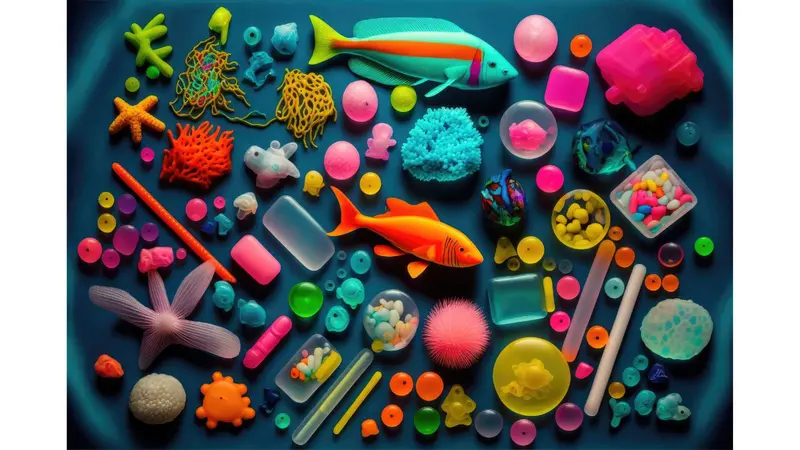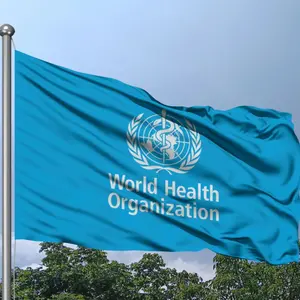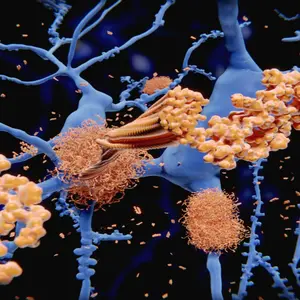

Emerging

Emerging
Microplastic Overload: Reducing Childhood Exposure
Exposure to plastics, microplastics and nanoplastics is a lifelong inevitability. Researchers are investigating the human health impacts of these synthetic materials, and while we have a growing picture of potential risks, additional scientific exploration is needed to know how petroleum-based polymers affect kids. Though it is impossible to hide from plastics, much can be done to limit children’s exposure.
Global plastic production was estimated to be about 430 million tons in 2021, and humans are continually finding new ways to use it because of its light weight, extreme temperature resistance and low cost. Although plastic takes hundreds of years to fully biodegrade, it breaks down into smaller components that find their way into the ground, air, water, food, clothing, wildlife and our bodies. Microplastics are smaller than five millimeters, while nanoplastics measure from one to 1,000 nanometers. Regardless of size, plastics are packed with toxic compounds, including phthalates, bisphenol A (BPA), polycyclic aromatic hydrocarbons, pesticides, heavy metals and polychlorinated biphenyls.
Studies have shown that microplastics are found in human tissue, including the lungs, placenta and blood. According to research published in Environmental Science & Technology, children consume and inhale an estimated 74,000 to 81,000 particles of microplastics annually. Those amounts could be higher for those that drink more water from plastic bottles than from the tap.
Nano and microplastics (NMPs) build up in the body. Another study published in Environmental Science & Technology reported that by age 18, children accumulate an average of 8,300 particles of microplastics in their tissues, and by age 70 that accumulation grows to 50,100 particles.
A small, but increasing, amount of research links plastic exposure to human health conditions. A review of data to date published in the International Journal of Molecular Sciences found evidence that exposure to NMPs affects both the digestive and nervous systems. The review identified microbiota alterations, intestinal barrier permeability (leaky gut), oxidative stress, inflammation, neurotoxicity and behavioral disturbances. While toxicological research on NMPs has not specifically focused on child health, kids’ immature defense mechanisms make them particularly vulnerable.
“Microplastics are a big problem for fertility,” asserts Jaclyn Smeaton, a licensed naturopathic physician specializing in fertility. The chemicals found in NMPs pose a threat to children’s future reproductive abilities.
Phthalates are chemicals used to make plastics more durable and can be found in flooring, lubricating oils and personal-care products. According to Yvonne Karney, a gynecologist and CEO of Vitality Renewal, “Phthalates are hormone disruptors that mimic estrogen. They off-gas chemicals that damage the cell membrane and mitochondria.” Studies have linked this chemical to reduced egg quality, less reproductive success and increased gynecological diseases in women; and lower sperm count, lower testosterone, reduced sperm quality and increased DNA damage in men.
Children have higher levels of exposure and are more vulnerable to phthalates. Research conducted by scientists from Columbia University, University of North Carolina and Harvard University found that phthalates increase children’s risks for learning, attention and behavioral disorders. Another study linked prenatal phthalate exposure to lower IQ and problems with attention, hyperactivity and poor social communication in children. “This is all so new, that we are just starting to learn about the effects of microplastics,” Karney remarks.
Limiting Microplastic Exposure
“The first tip is avoidance,” Smeaton says. Eliminate harmful plastics, in particular those labeled with the recycling codes 3 (phthalates), 6 (styrene) and 7 (bisphenols). To protect children, soft vinyl toys, old plastic toys and teething rings should be shunned.
“Wear cotton or wool,” recommends Karney. “Air dry synthetic clothes to limit microplastic release. Laundry balls can keep microfibers from breaking off.”
“I can’t overemphasize the importance of ensuring children are eating clean food and drinking clean water,” states Smeaton. In 2020, researchers found microplastics in fruit and vegetables, with highest levels of microplastics in carrots and apples.
“Eating organic can also help, though when contaminants are in soil or water, they can affect even organic produce,” warns Smeaton. “Limit the consumption of shellfish, rice, tea made using a tea bag, table salt and premade meals. Avoid cans and takeaway cups as these are lined with plastic to protect the food. Even if a container states BPA-free, it may still contain BPA’s cousin, bisphenol S.”
“Employing a water filter is great to remove contaminants, which exist both in city and well water. Reverse osmosis is best, but anything is better than nothing,” says Karney. Look for plastic-free alternatives for cooking and storing food like glass, steel, ceramic and bamboo. Karney also recommends never microwaving foods in plastic, limiting use of bottled water and dusting and vacuuming regularly to remove settled microplastics.
“Avoid exposing children to NMPs in personal-care products,” says Smeaton. She recommends choosing those that meet the standards of the Environmental Working Group (ewg.org/skindeep).
“Pick your battles; focus on what you can control,” Karney advises. “Find things that will not disrupt our life that are doable. It’s not that hard to get a filter for tap water; it is not that hard to get glassware for storing your food.”
Madiha Saeed is a holistic, functional and integrative doctor in Naperville, Illinois, and director of education for Documenting Hope and KnoWEwell.
Original article published at Natural Awakenings


 By
By







